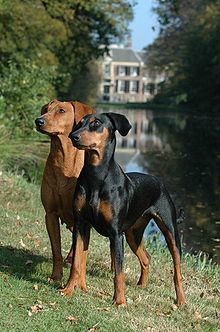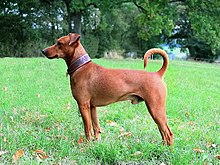German Pinscher
| German Pinscher | |||||||||||||||||||||||||
|---|---|---|---|---|---|---|---|---|---|---|---|---|---|---|---|---|---|---|---|---|---|---|---|---|---|
 The two coat colours, self-coloured red and black-and-tan | |||||||||||||||||||||||||
| Other names |
| ||||||||||||||||||||||||
| Origin | Germany | ||||||||||||||||||||||||
| |||||||||||||||||||||||||
| |||||||||||||||||||||||||
| Dog ( domestic dog ) | |||||||||||||||||||||||||
The German Pinscher or Deutscher Pinscher is a German breed of terrier in the Pinscher and Schnauzer group.[3][1]: 218 It shares common origins with the Schnauzer, of which it is essentially a short-haired equivalent.[4] It is seen in two colours, either black-and-tan or self-coloured red, this varying from deer-red to a dark reddish brown.[2]
It is an
History



The origins of the German Pinscher are unknown.[6] Dogs of this type, both rough-haired and smooth-haired, were traditionally kept as carriage dogs or as stable dogs, and so were sometimes known as Stallpinscher; they were capable ratters.[6] Both types were known as Deutscher Pinscher, and came from the same lineage; rough-haired and smooth-haired puppies could occur in the same litter.[6] The rough-haired Pinscher, which would later become the Standard Schnauzer, was also known as the Rattler.[6][7]: 152
The "smooth Pinscher" is mentioned by
The Pinscher almost disappeared in the years after the
The Deutscher Pinscher is an
Characteristics
The German Pinscher is of medium size, with weights for both dogs and bitches in the range 14–20 kg and a height at the withers between 45 and 50 cm.[2] The coat is dense, short and smooth; it may be either black-and-tan or self-coloured red, this varying from a light stag-red to a dark reddish brown.[2][1]: 218
References
- ^ ISBN 9781465408440.
- ^ a b c d e FCI-Standard N° 184: Deutscher Pinscher (German Pinscher). Thuin: Fédération Cynologique Internationale. Accessed March 2022.
- ^ a b FCI breeds nomenclature: Deutscher Pinscher (184). Thuin: Fédération Cynologique Internationale. Accessed March 2022.
- ^ a b c Deutscher Pinscher (in German). Witzenhausen: Gesellschaft zur Erhaltung alter und gefährdeter Haustierrassen. Archived 16 February 2022.
- ^ a b Die Rote Liste im Überblick (in German). Witzenhausen: Gesellschaft zur Erhaltung alter und gefährdeter Haustierrassen. Archived 30 January 2022.
- ^ a b c d e f g h i Christel Simantke (2003). Die Gefährdete Nutztierrasse des Jahres 2003: Gefährdete Haus- und Hofhunde: Von Spitzen und Pinschern (in German). Witzenhausen: Gesellschaft zur Erhaltung alter und gefährdeter Haustierrassen. Archived 6 June 2012.
- ^ a b Ludwig Beckmann (1894–1895). Geschichte und Beschreibung der Rassen des Hundes (volume II, in German). Braunschweig: Druck und Verlag von Friedrich Bieweg und Sohn.
- ^ a b Rasseportrait: Deutscher Pinscher (in German). Remscheid: Pinscher-Schnauzer-Klub 1895 e.V. Archived 23 March 2022.
